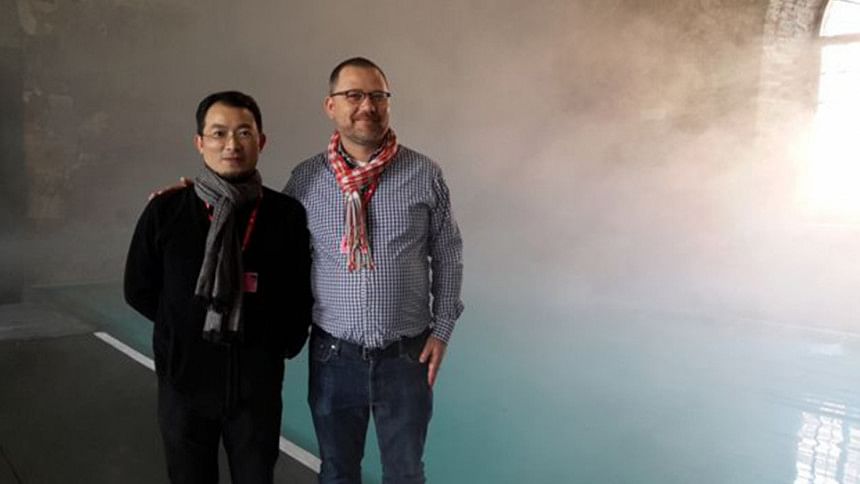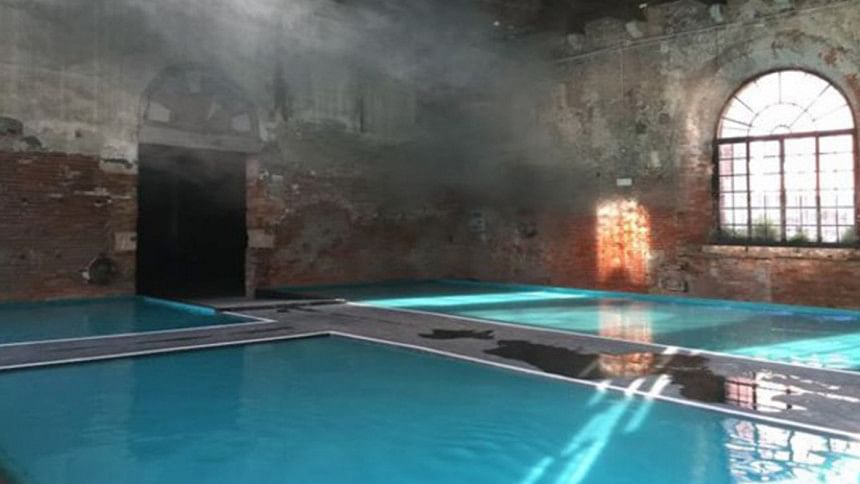Getting wet feet for Tuvalu

An artwork that gets your feet wet is about to be unveiled in Venice at the 56th International Biennale.
It's the national pavilion of the tiny Pacific nation of Tuvalu, which will be one of the first places in the world to disappear if sea levels continue to rise.
"It's a sinking nation combined with a sinking city," says the pavilion's creator, Taiwanese eco-artist Vincent Huang.
"This is the first floating pavilion in the Venice biennale's 120-year history."
Inside, a turquoise pool is crossed by two black walkways.
They give a little under our feet and the water seeps in, wetting the soles of our shoes. The idea is that the weight of the people on the walkways will cause this kind of "flooding", symbolically reproducing the impact of human beings on the environment.
Huang carefully chose the colour for the wooden pool's PVC lining, reproducing the exact shade of the "beautiful crystal blue of the Tuvalu lagoon".
"Tuvalu is the smallest national pavilion but we're dealing with the biggest global crisis," says Huang.
"I believe that most people have never heard about Tuvalu but it's an iconic victim in terms of climate crisis."

Huang has been dedicating his work to the island nation of 10,000 since a speech by Tuvalu's representative at the 2009 UN Framework Convention on Climate Change (UNFCCC) conference in Copenhagen.
"When Ian Fry tearfully said, 'The fate of my country rests in your hands,' that made everyone wakes up," he says.
"They make no carbon emissions. I always say, 'Zero carbon emissions but zero survival.' This is very unfair."
The entire installation has been constructed and assembled locally, overseen by Venetian architect, Cinzia Nardo, and all the materials used will be recycled when the exhibition closes in November.
Even the walkway we are standing on will be donated to Venice - a tongue-in-cheek homage to the elevated platforms used here by pedestrians when the water level rises and floods the streets. "This will be the only one that's been exhibited in the biennale!" says Huang.
In keeping with Huang's policies, this is the Venice biennale's first PaperSmart pavilion - no information is available in paper form, only digitally. The money saved will help to fund a mangrove-planting project to combat coastal erosion, which he describes as "a social sculpture involving the people of Tuvalu".
The pool is filled with local tap water, which will be filtered to prevent it from stagnating over the coming six months. Huang had originally hoped to use water from Venice's lagoon but permission was refused for hygiene reasons.
A fog machine creates misty reflections on the water, mixing at times with the natural light filtering through the windows or with a projected light to create an aurora effect. The aurora is a metaphor for modern civilization which, in Huang's words "looks beautiful but is just an illusion which disappears quickly."
The installation was inspired by Dao-ist philosophy, specifically the first chapter of the Book of Zhuangzi, called Free and Easy Wandering.
This includes a story about a giant fish that turns into a bird and flies high into the sky - the beating of his wings roils the waves until sea and sky merge and the land disappears.
Huang says he was encouraged to create the work by curator Thomas Berghuis, an expert on Chinese art.
"We are always talking about how humans can fight climate change but 97% is caused by humans!" says Huang.
"This is why Thomas and I wanted through ancient Chinese philosophy to give the message that humans should live with natural harmony not fight with it."
Huang has visited Tuvalu twice since the Copenhagen conference, and was appointed as an official delegate to the 2012 UNFCCC conference in Doha.
He will be returning to this year's conference in Paris with the man who inspired him, Ian Fry.
It didn't happen immediately but Fry came to realise how successfully art could be used to draw attention to Tuvalu's problems, Huang says.
"He told the prime minister and governor general that Vincent is doing very well."
One of the challenges associated with the Venice installation, called Crossing the Tide, was to get the authorities to allow him to use water and a fog machine in the pavilion's location - a 16th Century building in the Venetian Arsenal originally used as an artillery store.
And with just hours to go before the official opening on Wednesday, Huang and Berghuis are plotting yet another first.
"We are thinking maybe the curator, the president of the Biennale, the Tuvalu delegate and I could sit over there with our chairs in the water," he says, indicating the far side of the pool.
There is a mischievous twinkle in the artist's eye as he envisages the only opening ceremony in the Biennale's history to take place in the water. "But we still need to ask if President Paolo Baratta is happy about that!" he says, wondering where they will be able to get some boots.
"I'm actually very happy instead of wearing boots to roll up my pants," says Thomas Berghuis. It would be, he explains, a metaphorical gesture, "like the expression, 'roll up your sleeves and get your hands dirty'. In this case, get your feet wet."

 For all latest news, follow The Daily Star's Google News channel.
For all latest news, follow The Daily Star's Google News channel. 



Comments